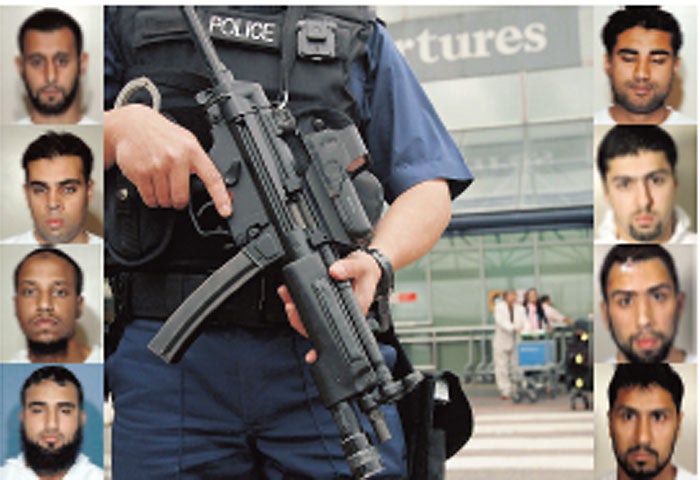Court told of plot to bomb transatlantic airliners

Eight British Muslims came within days of blowing up at least seven transatlantic airliners using liquid bombs disguised as soft drinks in a suicide plot which would have led to "death on an almost unprecedented scale", a court was told yesterday.
The men, described by prosecutors as "cold-eyed fanatics", were allegedly in the final phase of preparing a terrorist operation simultaneously to detonate devices using hydrogen peroxide similar to those used by the London bombers in July 2005. A covert police operation led to their arrest in August 2006.
The jury at Woolwich Crown Court heard that the alleged ringleaders of the conspiracy had selected as probable targets seven flights leaving within a period of two hours and 35 minutes from Heathrow airport's Terminal 3 to six cities in America and Canada including San Francisco and Montreal. But the court heard the plotters may have had ambitions to target as many as 18 jets leaving other terminals with suicide bombers on board, potentially leading to the highest terrorist death toll since the September 11 attacks in America.
The arrest of the group, who are accused of preparing to use bombs disguised in 500ml bottles of Oasis and Lucozade, led to a dramatic tightening of security and chaos at airports 18 months ago when passengers were banned from carrying liquids on to aircraft. All eight men deny charges of conspiracy to murder and endangering an aircraft by causing an explosion.
Peter Wright QC, for the prosecution, said the alleged conspirators, aged between 23 and 29, were united by a common interest that "involved inflicting heavy casualties on an unwitting civilian population all in the name of Islam".
It is claimed that each of the bombers would have carried the bombs and their detonators on board in hand luggage disguised as innocuous items such as AA-sized batteries, disposable containers and sealed drinks which had been injected with the liquid explosive using a syringe.
The court heard that the plot involved Boeing 777, 767 or 763 aircraft operated by three airlines – Air Canada, United Airlines and American Airlines. The jets, which each have a capacity of between 241 and 285 people, would have been in the air together for a period of at least six hours, making them vulnerable to a simultaneous suicide attack, the jury was told. Although no date had been selected, it is claimed the ringleaders had shown an interest in flights between 2 August and the end of October 2006.
Mr Wright said: "They are men with the cold-eyed certainty of fanatics, prepared to board an aircraft with the ingredients to construct and detonate a device to bring about the loss not only of their own lives but all those around them."
The alleged conspiracy began to unravel on 9 August when two of the defendants – Abdulla Ahmed Ali, 27, from Walthamstow, east London, and Assad Sarwar, 27, from High Wycombe, Buckinghamshire – met in a car park and were arrested by counter-terrorist officers. It is claimed that the two men, along with another defendant – Mohammed Gulzar, 26, from Barking – were the ringleaders and used a house in Walthamstow as the logistical centre for the conspiracy.
A computer memory stick found in the pocket of Mr Ali's jacket contained information which he insisted was a plan for a holiday in America.
Prosecutors say the data on the stick – flight schedules, airport security information and details of what could be carried as hand luggage – represented key groundwork for how and when to carry out the attacks.
Mr Wright said: "It seems that those interested in the fruits of this research appeared merely interested in a one-way flight. They did not appear to show any similar interest in flying back to the UK."
The seven flights, which had been highlighted on the memory stick data, would all have taken off from Terminal 3 between 2.15pm and 4.30pm destined for San Francisco, Toronto, Montreal, Washington DC and New York City, with two flights going to Chicago.
A diary found in Mr Ali's jacket also contained a "blueprint" for the attacks with shopping lists for bomb ingredients, information on how to assemble the explosives and instructions such as "Select date, five days before jet, all link up".
The other defendants, all from east London, are Tanvir Hussain, 27, of Leyton; Ibrahim Savant, 27, of Stoke Newington; Arafat Waheed Khan, 26, and Waheed Zaman, both of Walthamstow; and Umar Islam, 29, from Plaistow. The trial continues.
The make-up of a 'soft-drinks' bomb
*Prosecutors allege that the main charge of the devices consisted of hydrogen peroxide, a commonly available chemical used by hair dressers, mixed with a powdered base for soft drinks called Tang.
*If hydrogen peroxide is produced at sufficient concentration and then mixed with another 'energetic source', it has explosive properties.
*The explosive was to have been injected into the bottom of unopened Lucozade or Oasis bottles. The hole would then be sealed with glue.
*The main charge was to have been detonated with the chemical HMTD, which can also be made from commerciallyavailable substances, including solid fuel camping stoves.
*The HMTD was to be concealed in hollowed-out AA 1.5 volt batteries along with a wire fuse taken from a light bulb.
*An ignition device such as a portable camera would have been used to set off the explosion, the court heard.
Subscribe to Independent Premium to bookmark this article
Want to bookmark your favourite articles and stories to read or reference later? Start your Independent Premium subscription today.

Join our commenting forum
Join thought-provoking conversations, follow other Independent readers and see their replies